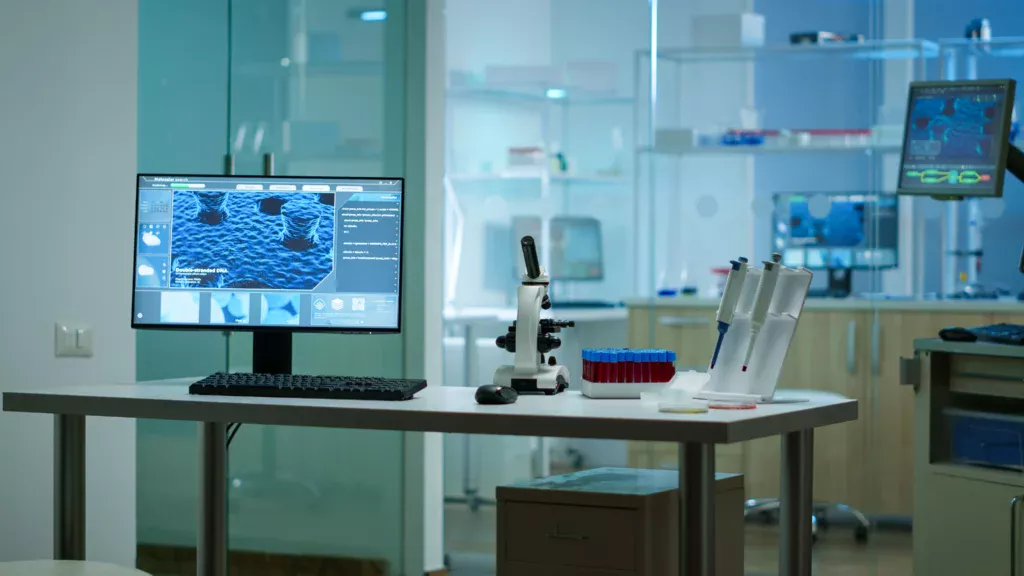
Pathology labs are the unsung heroes of the medical world. They are the places where the magic happens, where diseases are unveiled, and where healthcare decisions are born. In this blog, we’ll take a close look at what an ideal pathology lab looks like, the heartbeat of diagnostics that plays a crucial role in patient care.
What Does an Ideal Pathology Lab Include?
1.State-of-the-Art Equipment:
The foundation of any pathology lab is its equipment. Microscopes, centrifuges, and analyzers are the tools of the trade. In an ideal lab, these machines are not just up-to-date but also well-maintained for accuracy.
2.Experienced Staff:
A skilled team of pathologists, technicians, and support staff is essential. An ideal lab fosters a culture of learning and collaboration.
3.Sterile Environment:
Cleanliness is paramount. A Sterile lab environment minimizes contamination risks, ensuring reliable results.
4.Quality Control:
An ideal lab is obsessive about quality control. Regular checks and balances ensure that results are consistently accurate.
5.Accurate Records:
Proper record-keeping is non-negotiable. An ideal lab maintains meticulous records for traceability.
What Sets the Ideal Pathology Lab Apart?
1.Cutting-Edge Technology:
An ideal lab embraces technology. From digital pathology systems to advanced molecular testing, they stay on the cutting edge.
2.Efficient Workflow:
The lab has a well-planned workflow that minimizes bottlenecks. Sample tracking, processing, and reporting is seamless.
3.Prompt Turnaround Time:
In an ideal lab, tests are completed and results are delivered as quickly as possible. This is crucial for patient care.
4.Research and Development:
The lab invests in research. They are not just consumers of knowledge but contributors to it.
5.Patient-Centric Approach:
Patient care is at the core. The lab understands that every test represents a real person, and they treat it as such.
Welcome to the world of pathology! Whether you’re a pathology student or a medical professional considering a residency in this field, you’re embarking on a rewarding yet challenging journey. Let’s explore what pathology residency involves and how you can make the most of it. What Is Pathology Residency? A pathology residency is your journey to …
The hidden Astonishing Guide to Pathology Residency Read More »
In the ever-evolving realm of healthcare, one thing remains crystal clear: the importance of precise and timely medical information. However, our approach to diagnostics is evolving, especially in the field of pathology, where we are witnessing a profound transformation – the era of personalized medicine. The Power of Personalized Medicine The concept of personalized medicine …
Personalized Medicine: Ushering in a New Era of Pathology Read More »
The Role of Pathologists and Technicians
Pathologists are the captains of the ship. They oversee the lab’s operations, sign reports, and provide expert consultation to healthcare providers. They play a vital role in ensuring accurate diagnoses and contribute to patient care. Technicians are the lab’s backbone. They handle samples, run tests, and maintain equipment. Their meticulous work ensures the reliability of results. In an ideal lab, both pathologists and technicians work hand in hand.
The Heart of Diagnostics (Histopathology )
Histopathology is the study of tissues at a microscopic level. It’s one of the lab’s most critical functions. In an ideal lab, histopathology is performed with the utmost precision. Every slide is a window into the patient’s health.
Advanced Molecular Testing (Game Changer)
Molecular testing allows labs to delve deeper into diseases. It’s the future of diagnostics. Ideal labs are equipped to perform molecular tests, from identifying genetic markers to detecting viruses and bacteria.
The Challenges of an Ideal Lab
Creating an ideal pathology lab is no small feat. There are challenges, such as:
1.Cost:
State-of-the-art equipment and technology come at a price. Maintaining them can be costly.
2.Human Resources:
Skilled professionals are in high demand. Attracting and keeping the right people is a problem that organizations face regularly.
3.Accreditation:
Ideal labs often seek accreditation from regulatory bodies, a process that involves rigorous inspection and adherence to strict standards.
4.Compliance:
Labs must navigate a web of regulations and guidelines, which can be complex.
5.Data Management:
In the digital age, managing vast amounts of data is a challenge. Ideal labs have robust information systems in place.
The Future of Pathology Labs
Pathology labs are evolving. They are becoming more accessible, with telepathology allowing remote consultation. Artificial intelligence is poised to transform diagnostics, making processes more efficient and accurate.
Enhancing Patient Engagement
1.Patient Education:
Ideal labs engage patients by providing educational resources. They explain complex medical jargon in simple terms, helping patients understand their conditions better.
2.Online Portals:
Many labs offer online portals where patients can access their test results. patients can take control of their health with this.
3.Transparency:
Ideal labs are transparent about their processes. They let patients know what to expect during their visit and provide clear instructions for tests.
Innovative Test Menu
1.Comprehensive Test Menu:
An ideal lab offers a wide range of tests. From routine blood work to specialized genetic testing, they have it all under one roof.
2.Customized Panels:
Some labs offer customized test panels. This means doctors can order a set of tests tailored to a patient’s specific needs.
3.Rapid Testing:
Ideal labs have options for rapid testing when a quick diagnosis is crucial. This is especially important in emergency cases.
Accessibility and Convenience
1.Extended Hours:
They understand that healthcare doesn’t stick to a 9-to-5 schedule. Many ideal labs offer extended hours, making it easier for patients to get tested at their convenience.
2.Multiple Locations:
Ideal labs have multiple locations to serve a wider patient base. This ensures that patients don’t have to travel far for tests.
3.Home Collection:
Some labs offer the convenience of home sample collection. A phlebotomist visits the patient’s residence to collect samples.
Community Engagement and Health Camps
1.Health Camps:
Ideal labs often organize health camps in the community. These camps offer free or discounted tests, spreading awareness about common health issues.
2.Education Workshops:
They conduct workshops on health-related topics. These workshops empower people with knowledge to lead healthier lives.
Innovative Technology Integration
1.Mobile Apps:
Many ideal labs have mobile apps that allow patients to book appointments, access test results, and receive notifications on their smartphones.
2.AI Chatbots:
AI chatbots assist patients in scheduling tests, understanding preparation instructions, and answering common queries.
3.Virtual Consultations:
In the era of telemedicine, ideal labs provide the option for virtual consultations with pathologists, making healthcare accessible to remote areas.
Ensuring Data Security and Privacy
1.Robust Data Encryption:
Ideal labs prioritize data security by using robust encryption methods to protect patient information.
2.Compliance:
They adhere to all data protection regulations, ensuring that patient information is handled with care and responsibility.
3.Patient Consent:
Before conducting any test, ideal labs obtain clear consent from the patient regarding data usage and storage.
Patient Feedback and Continuous Improvement
1.Feedback Loops:
Ideal labs have systems in place for collecting patient feedback. They value opinions and use them for continuous improvement.
2.Regular Audits:
They conduct internal audits to identify areas that need improvement, whether in terms of quality control, service efficiency, or patient experience.
Community Initiatives
1.Medical Camps:
Ideal labs often collaborate with local medical professionals to conduct free medical camps, providing essential healthcare services to underserved communities.
2.Health Awareness Drives:
They participate in and lead health awareness drives to educate people about prevalent health issues and encourage preventive care.
A Beacon of Health in the Community
An ideal pathology lab extends beyond its clinical functions. It is a beacon of health and wellness within the community it serves. By prioritizing patient-centric care, innovative technology, and community engagement, these labs play a vital role in promoting better healthcare outcomes. As they continue to evolve and adapt, the future of ideal pathology labs holds the promise of even more advanced diagnostic capabilities and a broader reach, ensuring that healthcare remains accessible and patient-focused.
Patient-Centric Care
1.Empathy:
The staff in an ideal lab approach their work with empathy. They understand that many patients may be anxious about tests, and they provide reassurance and comfort.
2.Clear Communication:
An ideal lab ensures that communication is clear and easy to understand. They explain the purpose of tests, any necessary preparations, and what to expect during and after the tests.
3.Accessibility:
They maintain open channels of communication. Patients can reach out to questions or concerns, and they receive prompt and informative responses.
Pathology Education Initiatives
1.Pathology Student Internships:
Ideal labs often offer internships for pathology students. This hands-on experience helps students bridge the gap between theory and practice.
2.Educational Webinars:
They host webinars and educational sessions for pathology students and medical professionals. These sessions cover a wide range of topics and often include expert speakers.
3.Scholarships and Grants:
Some labs have scholarship programs to support the education of aspiring pathologists.
Investment in Research
1.Collaborations:
Ideal labs collaborate with academic institutions and research organizations to participate in cutting-edge research projects.
2.Publication:
They encourage pathologists and researchers within their team to publish their findings, contributing to the scientific community.
3.Innovation:
These labs are at the forefront of adopting innovative techniques and technologies that push the boundaries of diagnostics.
Accessible Healthcare for All
1.Affordable Testing:
Ideal labs often have a range of pricing options to make testing affordable for various income groups.
2.Community Outreach:
They organize medical camps in underserved areas, providing free testing and medical consultations to those who need it most.
3.Pro Bono Work:
In addition to their regular services, ideal labs engage in pro bono work to support critical healthcare initiatives.
Continuous Quality Improvement
1.Quality Audits:
Ideal labs regularly conduct internal and external quality audits to ensure that their services meet the highest standards.
2.Feedback Loop:
They actively seek feedback from medical professionals, patients, and their own staff to drive continuous improvements.
3.Technology Upgrades:
These labs are quick to adopt the latest diagnostic technologies and methodologies, ensuring that patients benefit from accurate and timely results.
Remote Consultations
1.Telepathology:
Ideal labs offer telepathology services, enabling pathologists to provide expert consultations even from a distance.
2.Patient Interaction:
They may have secure platforms for patients to interact with pathologists, ask questions, and discuss their results.
3.Online Second Opinions:
Patients can request online second opinions, allowing them to access expert advice without geographical constraints.
Green Initiatives
1.Environmentally Friendly Practices:
Some ideal labs are eco-conscious, implementing sustainable practices to reduce their environmental footprint.
2.Digital Reporting:
They reduce paper usage by providing digital test reports to patients and medical professionals.
3.Eco-friendly Facilities:
These labs may invest in energy-efficient equipment and building design to minimize their impact on the environment.

Conclusion (Shaping the Future of Healthcare)
Ideal pathology labs are not just healthcare facilities; they are beacons of health and knowledge in their communities. By prioritizing education, accessible healthcare, quality improvement, and innovation, they play a vital role in shaping the future of healthcare. As they continue to evolve, these labs hold the promise of improved diagnostics, greater community impact, and a healthcare system that is both patient-centric and forward-thinking.


Your article helped me a lot, is there any more related content? Thanks!
Great to hear that our article helped you! If you’re looking for more interesting blogs, check out our Insight section. You’ll find similar content that you might enjoy. Thanks for reading!